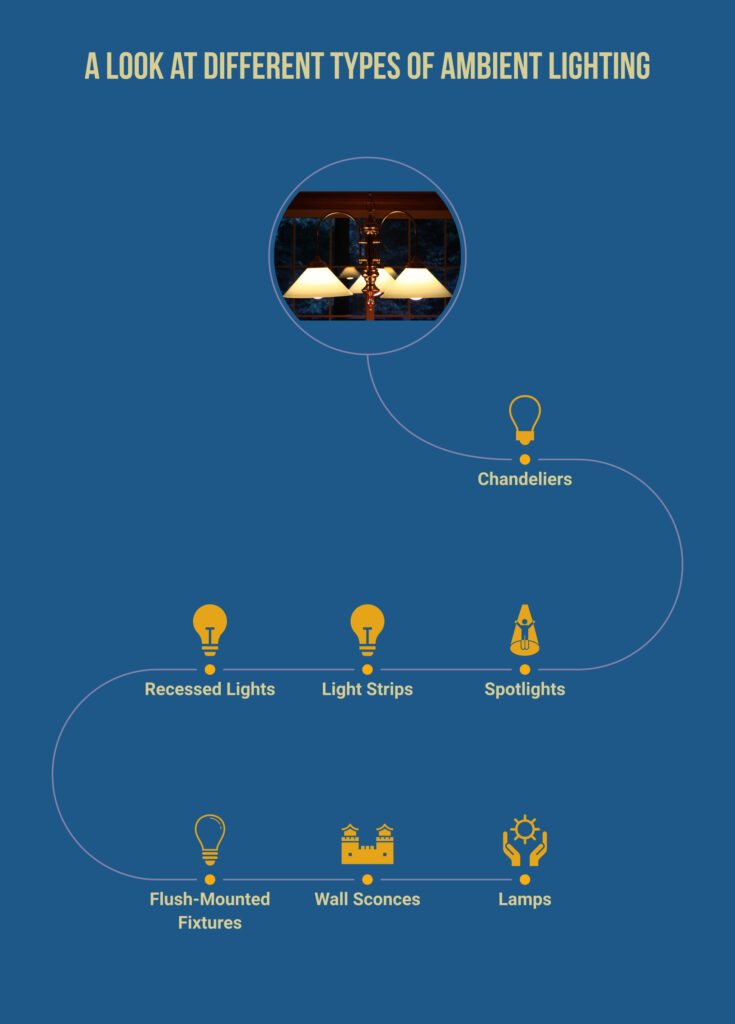How To Add Ambient Lighting To A Room

How To Add Ambient Lighting To A Room
Do you ever wish you could spruce up your home’s interior without replacing its current furnishings or shelling out a fortune to do so? Surprisingly enough, the solution may be as easy as changing the lighting in your room!
Ambient lighting may provide a relaxing and serene atmosphere while enhancing the appeal of your current design. Are you interested in finding out more about how adding ambient light can turn any living space into a chic haven?
Keep reading for our guide on how to add ambient lighting to a room – it’s easier than you think!
How Does Ambient Lighting Work?
Ambient lighting, often known as general lighting, is a space’s primary source of light. Unlike accent lighting, which draws attention to a room’s characteristics, or task lighting, which focuses on a particular activity, ambient lighting illuminates a space uniformly. It functions as the illumination in your room’s foundation. It would be impossible to see and move around without ambient illumination. Thanks to the gentle, natural light, you feel at ease and have the clearest possible vision of your space.
Common Types of Ambient Lighting

To make your area seem cozy and inviting, you may utilize a variety of ambient lighting styles. These consist of:
🌞 Chandeliers
A chandelier enhances a space like a beautiful piece of jewelry. You may make a wonderful focal point in your living room by placing a lovely chandelier in the center of the ceiling. Although it’s typical to think of chandeliers as magnificently hanging over dining tables, adding a classy, sizable chandelier to a living area with high ceilings may lend an opulent elegance.
However, remember that a chandelier doesn’t have to be the sole illumination source in your living room, especially because these spaces are frequently the largest in our houses. I prefer to think of the chandelier in the living room as a nice adornment rather than the only light source. If your living room contains a chandelier, add a dimmer to it. It is ideal for your room since it lets you customize the environment and mood.
🌞 Spotlights
Another excellent option for ambient lighting is spotlights. They’re like the superheroes of lighting—always willing to step in and rescue the day! Imagine that you have a special spot in your space with lovely artwork or an interesting piece of furniture. These distinctive places can be brought to light by spotlights, which will stand out.
Since they are movable, you may point the light beam in any direction. They are really fascinating since they can be recessed into the ceiling, taking up no more area in the house. Spotlights could be the best option if you’re like me and enjoy flaunting your favorite stuff.
🌞 Light Strips
Light strips are sleek subtle, and they can go almost anywhere. Is there a bookshelf you want to highlight or add a soft glow behind your TV for movie nights? Light strips can do that! Attaching them to the back of furniture pieces or even along the baseboards is super easy. The best part is they come in a variety of colors, so you can choose the perfect hue to match your room’s decor.
One of my favorite tricks is to use light strips under my bed. It gives off a magical floating bed illusion. Plus, if you wake up thirsty in the middle of the night, you have just enough light to guide you without disturbing anyone else’s sleep. Remember, the key is to get creative and think about where you want your attention drawn in the room.
🌞 Recessed Lights
Recessed lighting is the most typical kind of ambient lighting, commonly called can lighting. They serve as the foundation of a room’s lighting system since they distribute light evenly across the space. Recessed lighting is fantastic since it leaves you more room to decorate and arrange your furniture because it doesn’t take up any space on your walls or floors. I particularly appreciate that they can be dimmed, which enables you to easily alter the atmosphere and tone of your space with the flip of a button.
🌞 Flush-Mounted Fixtures
Flush-mounted fixtures sit flush against the ceiling, similar to recessed lights. They’re perfect for rooms with lower ceilings because they don’t hang down and take up headspace. They come in various styles, from modern to traditional, so you can choose one that matches your room’s aesthetic. I particularly love using these in hallways or smaller rooms because they provide ample lighting without being obtrusive.
🌞 Wall Sconces
Wall Sconces are like the fairy godmothers of lighting. They’re there to cast a warm, inviting glow and make your room look magical. Wall sconces are typically mounted on the wall and can cast light upwards, downwards, or both, depending on the style you choose. The cool thing about wall sconces is that they can be used to create a beautiful balance of light when paired with other lighting sources.
Plus, they’re a great way to add extra lighting without taking up floor or table space! They’re particularly useful in hallways or on either side of a bed or fireplace.
🌞 Lamps
Lamps are the most versatile type of ambient lighting. While a floor lamp may warm up a gloomy spot and provide light, a table lamp is excellent for reading. Additionally, lamps may be a stylish addition to your room’s decor and serve a practical purpose. For instance, a special table light might be a fantastic discussion starter when you have company around.
Desk lights should also be kept in mind because they are ideal for use when reading or working on schoolwork late at night. Most significantly, many lights have dimmable brightness settings, so you can always vary the ambiance of your space.
The Importance of Planning
Planning is a crucial step that you shouldn’t neglect before adding ambient lighting to your space. It’s similar to directing a movie; you would only begin shooting after writing a script, right? Lighting follows the same principle. It’s important to picture how you want your space to feel and appear.
Without a strategy, you can find yourself in a space that is either too illuminated and seems more like a spotlight or underlit and feels too dark and dismal. Because of this, I make it a point to lay everything out before I add any lighting. It enables me to ensure that the place I’m designing is aesthetically appealing and practical for my purposes.
Factors to Consider

When planning, there are some key factors to consider, and they’re the ingredients to your favorite recipe – you need them all to get the perfect dish.
✅ Room Size
The size of your room plays a huge role in the amount and type of lighting you need. Larger rooms need more than one type of ambient light to fill the space adequately, while smaller rooms could be perfectly lit with just a single light source. Always remember, it’s about filling the room with a soft, comfortable light, not overwhelming it.
✅ Color Scheme
The color scheme of your room also affects your lighting. Dark colors absorb light and give the impression that a space is smaller and darker, whereas light colors reflect light and can make a space appear brighter. So, if you have a room with dark walls, you might need more or stronger lights to get the ambiance you want.
✅ Purpose of the Room
Lastly, think about what you usually do in the room. If it’s a place where you do tasks that need good lighting, like reading or cooking, you’ll need brighter lights. But if it’s a room where you relax and unwind, a softer, dimmer light might be better.
Ways on How To Add Ambient Lighting To A Room

I love using a combination of these different types of ambient lighting in my own room. It creates a layered effect and allows for flexibility in changing the mood and ambiance as needed. But, it’s about more than just the type of lighting you choose, but also how and where you place them. Here are some tips on how to add ambient lighting to a room:
🏚 Layered Lighting
Just like how you wear different layers of clothes to be comfortable in any weather, the same principle can be applied to lighting your room. When I say ‘layer your lights,’ I’m talking about using a mix of different lighting types to create a balanced and comfortable environment. You can have a chandelier for a grand look, a lamp for reading, and a light strip to highlight your favorite photo wall.
By using these different types, you create layers of light in your room that can be adjusted depending on what you’re doing or how you’re feeling. It’s like having a wardrobe of lights at your disposal!
🏚 Incorporating Dimmers
Utilizing dimmable lights is one of the best ways to fine-tune the ambient lighting in your room. It is like having a magic wand that lets you control your room’s atmosphere. Lights that can be dimmed are versatile and can be used in any room in your house. You can put them on your bedside table, use them in your living room when your friends come over, and even in your kitchen.
When set on bright, these lights are perfect for active tasks like playing board games or preparing dinner. If you want a more relaxed atmosphere, just set them to medium. And if you want to create a “chill zone” or you’re watching a movie, set them on low. It’s that simple! And the coolest part is you don’t need any special switches to make your lights dimmable. Just replace your regular bulbs with smart bulbs, and you’re good to go!
🏚 Using Lamps and Wall Sconces
Lamps and wall sconces can add personality to your room. Placement is key, and I’ve found some spots where they work best. For lamps, consider placing them in corners of your room where natural light doesn’t reach. This can make your room feel more spacious and inviting. I also like to put a lamp near my reading chair for better light while reading.
Now, let’s talk about wall sconces. They’re perfect for hallways or staircases, but you can also place them on either side of your bed or above your nightstands. This can create a cozy, relaxing environment perfect for winding down at the end of the day.
Plus, they’re a great alternative to table lamps if you have a small bedroom with limited space. Just remember, the key to using lamps and wall sconces effectively is to consider the function of the area and how the lighting will impact the mood you want to create.
🏚 Use Natural Light
Don’t forget about the most natural and cost-effective source of ambient light – the Sun! During the day, let as much natural light into your room as you can by opening your curtains or blinds. Not only is it good for your mood and health, but it also helps to save on electricity. You can use light, sheer curtains to diffuse the sunlight and create a soft, warm glow in your room.
Also, remember that the color of your walls can affect your room’s brightness. Lighter colors reflect sunlight, while darker colors absorb it. So, if you want a bright, sunny room, consider painting your walls a light color. Darker colors are a good choice if you want a cozy, dimly lit room. In short, use natural light to your advantage; it’s the best way to add ambient lighting to a room!
Frequently Asked Questions
Q: How do I use LED strip lights for mood lighting in my bedroom?
LED strip lights are a fantastic option for mood lighting in your bedroom. You can install them along the edges of your furniture, behind your headboard, or around the perimeter of your room. They offer a wide color spectrum, allowing you to set the tone that fits your mood or activity. Remember, placement is key for achieving the desired effect.
Q: What’s the role of pendant lights in interior design?
In addition to their functional role, pendant lights act as a crucial element in interior design. They can be used as accent lights, providing a focal point and adding aesthetic appeal to your spaces. Over a dining table or kitchen island, they offer task lighting, while in the living room or bedroom, they supply softer, ambient light.
Q: How can I use indirect lighting for home decor?
Indirect lighting is a subtle way of adding depth and ambiance to your home decor. By directing light toward the ceiling or a wall, it gently diffuses to illuminate the room, creating a relaxing atmosphere. You can achieve this effect using wall sconces or LED strip lights installed in alcoves or behind furniture.
Q: What color temperature is best for living room lighting?
The best color temperature for living room lighting depends on the mood you want to create. For a cozy, relaxing atmosphere, go for warm light with a color temperature of around 2700K. If you want a more energetic, vibrant ambiance, choose cool white light around 4000K.
Q: Can LED bulbs be used for overhead lighting?
A5: Absolutely! LED bulbs are excellent for overhead lighting. They’re energy-efficient, have a longer lifespan than traditional incandescent bulbs, and come in various color temperatures. This makes them highly versatile for various lighting situations, whether task lighting in your kitchen or ambient light in your living room or bedroom.
Conclusion
In a nutshell, adding ambient lighting to a room isn’t as hard as it may seem. It’s all about understanding your space, needs, and preferences. Whatever route you go down, make sure what you choose blends effortlessly with the rest of the décor. Doing this will ensure you’ve got it right for your taste. So go ahead and give it a try – your home has never looked better! And remember that when it comes to reflecting your style through proper illumination, you’re the sole architect.






